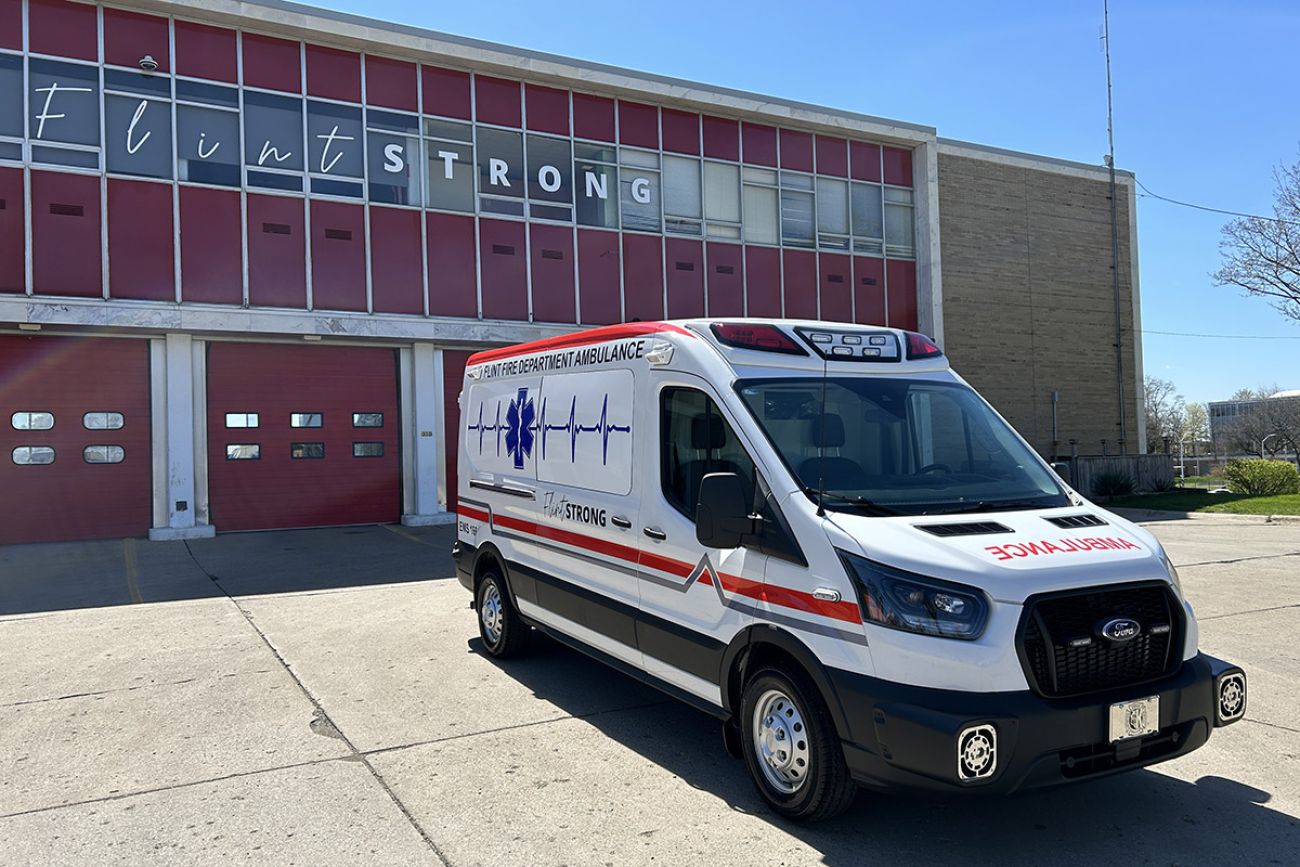Flint buys an ambulance with opioid funds. Critics sound alarms

- Flint uses opioid settlement funds to purchase a new ambulance and plans to buy three more
- Critics question the spending, arguing it will take money away from fighting the opioid epidemic
- Flint officials defend move to help reduce ambulance wait times, including calls that ‘involve overdoses’
There’s a shiny new ambulance parked at a Flint fire station that is drawing controversy even before it makes its first run.
The $225,000 mobile medical unit is the first of four ambulances the city expects to purchase with money intended for drug treatment, prevention and recovery services coming to the city through its share of a national lawsuit settlement with opioid manufacturers and distributors.
Mayor Sheldon Neeley calls it a win for Flint residents who’ve struggled with long waits for ambulances. But addiction service advocates say it violates the spirit — if not the letter — of a legal settlement seen as a once-in-a-lifetime chance to address an epidemic that has killed more than 11,000 Michiganders since 2018.
The ambulance purchase is believed to be the first in Michigan funded with opioid settlement dollars. The ensuing controversy could be a harbinger of growing tension between addiction treatment centers and the cash-strapped cities and counties in which they operate, particularly in a state with little oversight of opioid fund spending.
“This is not within the ballpark” of how the funds are supposed to be used, said Jonathan Stoltman, director of the Michigan-based Opioid Policy Institute, a national research think tank based in Grand Rapids.
Related:
- One of Michigan’s top doctors hid a secret from everyone. His drug addiction
- A push to legalize drug test strips, protect 'harm reduction' tactics in MI
- Michigan taps opioid funds for tiny drug victims — babies in withdrawal
The settlement lays out parameters for use of the funds, focused on addiction services for prevention, treatment and recovery. But “it sounds to me like they just wanted to buy ambulances,” Stoltman said.
Overdoses killed nearly 3,000 Michigan residents in 2022, more than the number of those killed by car crashes and guns combined. Opioids were the cause of 80% of those deaths, with a Michigander dying of an overdose every four hours.
Michigan is expected to get $1.6 billion in opioid settlement funds over 18 years from the settlements, with $181 million received through 2023. That money is split roughly evenly between the state and local units of government.
Making the most of the unparalleled windfall is critical to lessening the crushing toll of opioids. Compared to other states, though, Michigan provides little spending guidance to local governments, which will receive about $725 million, or nearly half the settlement total. Nor is the state tracking how localities spend the money.
The state, counties, cities and townships are supposed to follow spending guidelines set up by the settlements. Allowable uses, as laid out in what is called Exhibit E, revolve around prevention, treatment and recovery services for those suffering from opioid use disorder.
Genesee County, where Flint is the largest city, had the second-highest rate of drug overdose deaths among Michigan’s 83 counties in 2021, the most recent year for which data is available.
To help address the epidemic, the city of Flint is scheduled to receive $17.3 million over 18 years of settlement payments. It received $2.1 million in 2023 and will collect another $2.5 million by the end of 2024.
If Flint moves ahead with purchasing three additional ambulances at the same price as the first, the combined $900,000 price tag would equal nearly 20% of the $4.6 million in settlement funds it will have access to by the end of this year.
Neeley told Bridge Michigan he believes that ambulances fit within guidelines because some ambulance calls “involve overdoses.”
But in announcing the ambulance purchase, Flint did not mention opioids or the settlement fund until the ninth paragraph of a 10-paragraph press release. The city instead focused on reducing ambulance wait times.
“Flint residents are experiencing unacceptable wait times in their most vulnerable medical moments, and they must have access to lifesaving medical attention and transport,” Neeley said in the release.
Indeed, there is a statewide shortage of ambulance workers, so serious that at times there is only one ambulance on duty covering the 600-square-mile county, according to Neeley. Wait times for an ambulance can be as long as 30 minutes. “If you’re having a heart attack or a stroke,” Neeley told Bridge, “every minute counts.”
For now, Neeley said the city plans to staff ambulances with firefighters who have received some life-saving training, some of whom will eventually become certified paramedics.
Addressing that ambulance shortage with opioid settlement funds, though, is “on the fringe” of what is allowed, said Cara Poland, chair of the Michigan Opioid Advisory Commission, which was created by the Legislature to offer recommendations on how the state can best battle the epidemic.
“Is it outside the letter of the settlement? Probably not,” Poland said. “But Is it outside the spirit (of the settlement) to save lives related to opioid addiction? Probably.
“These dollars are intended to fill mental health and substance use (gaps),” Poland said. “Is buying four ambulances the best way to address the crisis or are they using this to solve a different concern?”
Nationally, some local governments have used opioid settlement funds for purchases that aren’t directly tied to opioid remediation, like new police cars. One county in Indiana used funds to pay for existing staff salaries, and then it used the freed-up funds to purchase an ambulance.
In Michigan, Kalamazoo and St. Clair counties purchased $200,000 body scanners that detect hidden drugs on the bodies of jail inmates — purchases that addiction service advocates have also criticized.
Kolby Miller at Medstar Ambulance, which provides medical services in Genesee County, questioned the wisdom of Flint using one-time dollars for an ongoing expense like ambulance service.
“It might buy you the truck but what puts gas in it five years from now,” Miller said.
Paula Nelson, president of Sacred Heart, which provides outpatient treatment services in Flint, told Bridge she’s unfamiliar with the city’s plans for ambulances. But she said “the money needs to be spent on the areas that are outlined in the settlement documents.”
Flint has so far spent about $640,000 of its opioid settlement funds on other services, including treatment and recovery programs. Neeley, the mayor, believes purchasing ambulances can save lives in the same way addiction services can.
“Death is a debt that can’t be overcome,” he said.
That’s not a good enough reason to use the money in a way that was not intended, said Stoltman, of the Opioid Policy Institute.
“There are reasons why cities like Flint got a lot of money — it’s because they have addiction problems,” Stoltman said. “The promise of this money is to try to fix the addiction crisis”
Buying ambulances, he said, “is not where the money’s supposed to go.”
See what new members are saying about why they donated to Bridge Michigan:
- “In order for this information to be accurate and unbiased it must be underwritten by its readers, not by special interests.” - Larry S.
- “Not many other media sources report on the topics Bridge does.” - Susan B.
- “Your journalism is outstanding and rare these days.” - Mark S.
If you want to ensure the future of nonpartisan, nonprofit Michigan journalism, please become a member today. You, too, will be asked why you donated and maybe we'll feature your quote next time!




